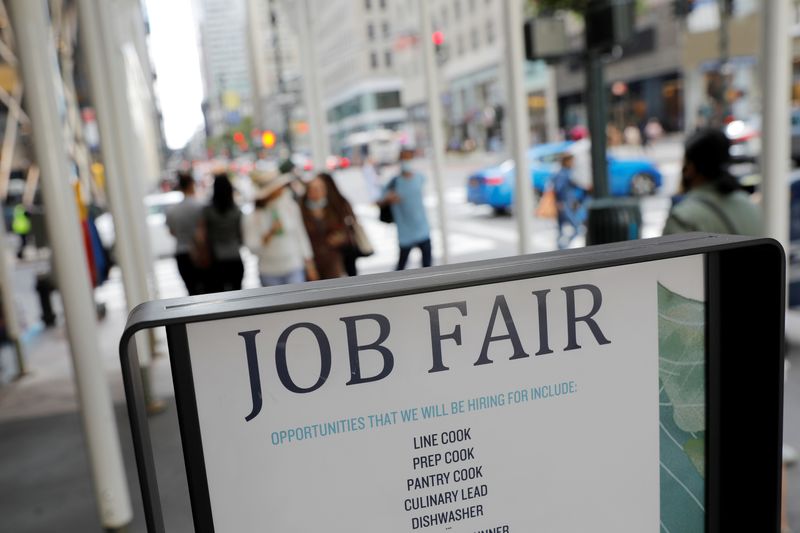By Lucia Mutikani
WASHINGTON (Reuters) - The number of Americans filing new claims for unemployment benefits increased to a two-month high last week, though labor market conditions remain fairly tight.
The weekly claims report from the Labor Department on Thursday also showed fewer people remaining on jobless rolls towards the end of March, suggesting that laid-off workers continued to find work, just not as easily as two years ago.
"The labor market remains very strong," said Gus Faucher, chief economist at PNC Financial (NYSE:PNC) in Pittsburgh.
Initial claims for state unemployment benefits rose 9,000 to a seasonally adjusted 221,000 for the week ended March 30, the highest level since late January. Economists polled by Reuters had forecast 214,000 claims in the latest week. Claims had bounced around between 210,000 and 212,000 for much of March.
Some economists attributed the larger-than-expected rise in claims to an early Easter this year, which could have thrown off the model that the government uses to strip seasonal fluctuations from the data.
Unadjusted claims increased 2,455 to 196,376 last week. There were significant rises in filings in California, Iowa, Illinois and Pennsylvania. These offset notable declines in Texas, Missouri and Georgia.
"We won't infer anything from one week's rise in claims, particularly since it occurred around a holiday, when claims data can be noisier than usual," said Nancy Vanden Houten, lead U.S. economist at Oxford Economics in New York.
Though layoffs increased to a 14-month high in March, job cuts were little changed compared to the same period last year.
There were 1.36 job openings for every unemployed person in February compared to 1.43 in January, government data showed this week. Worker shortages persist in industries like construction. Labor market resilience is anchoring the economy.
The economy's strength, combined with still-high inflation, could see the Federal Reserve delaying much-anticipated interest rate cuts this year.
Fed Chair Jerome Powell reiterated on Wednesday that the U.S. central bank has time to deliberate over its first rate cut. Since March 2022, the Fed has raised its policy rate by 525 basis points to the current 5.25%-5.50% range.
Stocks on Wall Street were trading higher. The dollar fell against a basket of currencies. U.S. Treasury prices were lower.
SOLID JOB GAINS EXPECTED
The number of people receiving benefits after an initial week of aid, a proxy for hiring, dropped 19,000 to 1.791 million during the week ending March 23, the claims report showed.
The insured unemployment rate was unchanged at 1.2%, consistent with a still-tight labor market.
The claims data have no bearing on March's employment report, scheduled to be released on Friday, as they fall outside the survey period. Nonfarm payrolls likely increased by 200,000 jobs last month after rising by 275,000 in February, according to a Reuters survey.
The unemployment rate is forecast unchanged at 3.9%. Labor market strength is boosting consumer spending, which is pulling in imports. A separate report from the Commerce Department's Bureau of Economic Analysis showed the trade deficit widened 1.9% to $68.9 billion in February.
Economists had forecast the deficit little changed at $67.3 billion. Exports jumped 2.3% to an all-time high of $263.0 billion. Goods exports accelerated 2.9% to $176.7 billion.
There were increases in exports of industrial supplies and materials, which include crude oil. Food exports rose $1.7 billion, boosted by soybeans. Capital goods exports increased $1.5 billion to a record high $53.0 billion, amid a rise in civilian aircraft.
But exports of motor vehicles, parts and engines decreased $1.3 billion. Exports of services rose $0.8 billion to an all-time high of $86.4 billion, lifted by travel and transport.
Imports advanced 2.2% to $331.9 billion in February, the highest level since October 2022. Goods imports shot up 1.8% to $268.1 billion. There were increases in imports of consumer goods, food as well as motor vehicles, parts and engines.
Services imports rose $2.4 billion to a record $63.8 billion. Businesses are importing more goods to rebuild inventories and meet strong domestic demand, which should blunt some of the anticipated hit on gross domestic product growth from the widening trade gap.
When adjusted for inflation, the goods trade deficit increased 1.2% to $87.0 billion in February. Economists estimated that trade could subtract as much as 0.75 percentage point from GDP growth in the first quarter.
Trade added 0.25 percentage point to the economy's 3.4% annualized growth rate in the October-December quarter after being neutral for two straight quarters.

The Atlanta Fed lowered its first-quarter GDP growth estimate to a 2.5% rate from a 2.8% pace.
"There's a decent chance that trade may end up being a larger drag on first-quarter GDP growth than we have been anticipating," said Daniel Silver, an economist at JPMorgan in New York. "This likely will be due in part to strength in imports, which reflects firming in domestic demand."
